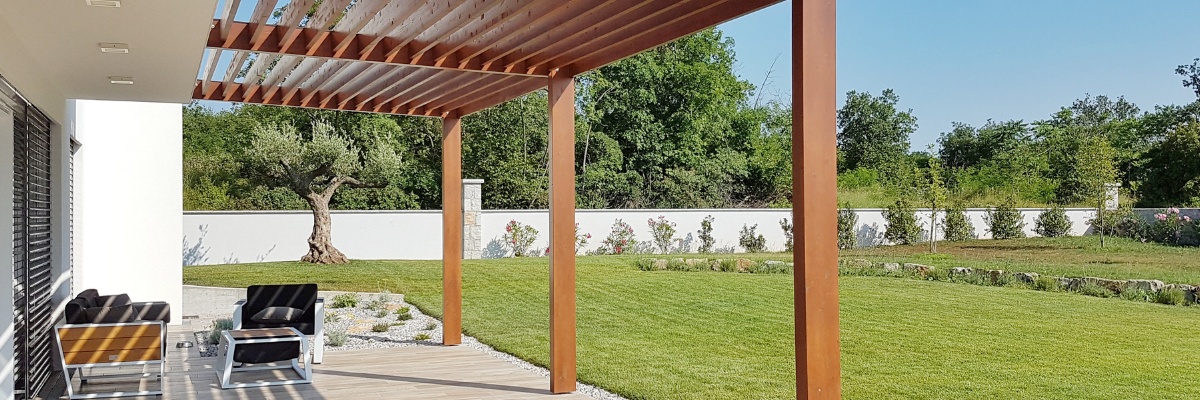
Passive houses are more than a trend; they represent a revolution in the way we live and build. They help us save money and care for the planet simultaneously.
The growing interest in energy-efficient homes has been largely driven by the European Directive 2010/31/EU. This regulation stipulates that, from 2020 onwards, all new buildings must have nearly zero energy consumption. It’s interesting to note that for public buildings, this requirement became effective already in 2018. The implementation of this directive reflects a growing commitment to sustainability and energy efficiency, marking a significant milestone in the construction of homes and buildings in Europe.
Currently, in Spain, there are 133 passive houses according to the Passive House Building Platform, with around 30,000 certified worldwide. The aim of these types of homes is to seek maximum comfort and achieve performance and energy efficiency levels higher than those required by regulations.
To give you an idea, in single-family homes, the energy savings have exceeded, in all cases, 50% compared to what is mandated by the Technical Building Code (CTE), obtaining an A Energy Rating.
The most notable difference in favour of passive houses is their high energy efficiency, considering that a passive house can reduce the electricity bill by up to 80%.
We tell you everything you need to know about passive houses and their benefits for you and the planet. Keep reading!
Índice de contenidos
What is a Passive House?
Passive houses, or “Passivhaus” in German, represent an innovative way of building. They aim for maximum energy efficiency and optimal indoor comfort. The best part is that they reduce the need for conventional heating or air conditioning systems. This not only helps your wallet but also the planet.
The concept of passive houses began in the 1970s, in response to the oil crisis and a rise in environmental awareness. Since then, it has evolved into a standard for sustainable construction. It is applied in homes, offices, and public buildings, both in new projects and in renovations.
The European Union agrees with this approach. Since 2018, it has required that all new buildings consume very little energy and promote the use of renewable energies.
The design of these houses is crucial. The climate, geography of the location, and orientation of the house are taken into account to maximise the use of sunlight. Materials that provide excellent insulation are used, and thermal bridges are avoided. This helps to keep the house warm in winter and cool in summer.
To ensure that fresh air is always circulating, a special ventilation system is used. This system keeps the air clean and at the right temperature, all without losing energy.
Basic Passivhaus Principles
When we talk about passive houses, we refer to well-designed constructions with a clear purpose: to drastically reduce the energy needs for heating and cooling. Achieving up to a 75% savings in these areas is not an easy task, but it is entirely possible thanks to the implementation of specific technologies and construction elements.
The motto of passive houses is ‘Live better by consuming less’. This demands a careful selection of materials and design to take advantage of the natural resources of the environment, thereby reducing the need for climate control systems.
A passive house is more than just a wooden house or a building with Passivhaus certification. It is a broad concept that involves a well-thought-out and well-made dwelling.
A passive house takes advantage of sunlight, positioning daytime areas where there is most sun and creating natural ventilations. In summer, openings are protected, and heat is stored in thick walls, all well insulated to prevent heat loss. Materials that store heat and insulations that allow vapor to pass through are used to avoid moisture. All joints are well sealed to prevent heat loss, and high-efficiency windows are chosen.
The Passivhaus standard certifies buildings with almost zero energy consumption and defines basic Passivhaus principles for constructing projects that consume very little energy. Here are the 5 basic principles of a passive house that we detail below:
The 5 Basic Principles of a Passive House
For a passive house, 5 basic principles are followed. They are essential and achieved with specific construction techniques. Although there are different ways to make a passive house, these principles form the foundation.
Reduction of thermal bridges certain points in the structure can be more complex to insulate. Corners, joints, or points of installation exits are susceptible to the formation of thermal bridges. Special attention is needed for these areas.
Heat recovery with mechanical ventilation
Controlled ventilation improves air quality by removing particles such as pollen or pollutants thanks to the system’s filters. Additionally, technical elements are included that assist in heat retention. Outdoor air is used to condition the interior, renewing the air and keeping it clean.
Airtightness to the Outside The quality of the construction is verified, and leaks are corrected to improve energy efficiency.
Complete Thermal Insulation
A complete envelope of the building with thicknesses exceeding the legal minimums must be achieved. Depending on the location of the dwelling, one material or another will be chosen. It is important that it is seamless and fulfills its function.
High Quality in Doors and Windows
These components are the major points of heat transmission, so it is essential to use high-efficiency carpentry. Double or triple glazing with inert gas inside is one of the most common solutions.
These principles help to build more efficient and comfortable houses, following Passivhaus standards.
11 Benefits of a Passive House
There is a wide variety of benefits that lead to a notable increase in this form of construction. Here are some of the most relevant ones that will make you opt for this model:
Energy Savings
Its consumption is almost zero, therefore, your bill is close to zero. This is because they are built with insulating elements and make use of renewable energies.
Enjoy the silence
Thanks to acoustic insulation, you will enjoy silence and tranquillity in your home. Using thermoefficient windows and well-sealed walls reduces energy consumption and, at the same time, reduces outside noise. This is the philosophy of passive design. With a single mechanism, several problems are solved at once.
Breathe pure air
The indoor air is of high quality and free from pollen or pollutants. Sometimes headaches or some allergies are caused by the air. Thanks to mechanical ventilation, the air is purified and ventilated.
Carbon emissions are reduced
Passive houses are a wonder for our planet. Did you know that they emit almost no greenhouse gases? Thanks to their incredible insulation, they cut CO2 emissions at the root. And there’s more: as they hardly need heating or air conditioning, these emissions are further reduced.
More profitable homes
Although their construction requires a higher initial investment, the difference is recouped within a few years. Moreover, they do not lose their value, but rather appreciate.
More Comfort
Having a more stable indoor temperature, consequently, you will enjoy more comfort. Not just in terms of temperature but also due to the absence of annoying noises.
Tax Benefits
Several countries offer subsidies or social aid for people who opt for this type of construction. Even in some banks, mortgages are cheaper.
Odours Won’t Bother You
If you are sensitive to odours, with this type of construction, you will be completely isolated from outside smells. For example, if you are in the countryside, the smell of fertilisers won’t bother you.
Very Efficient Windows and Glass
Thanks to the excellent insulation of double and triple glazing, a constant temperature is maintained and the entry of ultraviolet rays is prevented.
Less Dependent on Electricity
Passive houses are equipped with the best in thermal insulation, double or triple-glazed windows, and the latest construction techniques. This turns the dwelling into a true fortress against climatic variations. The heat produced by appliances, sunlight, or even the body heat of the people living there is retained inside, thus avoiding energy losses.
When the climate is cold, the house remains warm and cosy, while on hot days, it remains cool and comfortable. All this without the need to excessively depend on heating or cooling systems.
A Conscious House
One cannot calculate the level of ecological awareness of a family, people who decide to pay more to have a lower cost for the planet and life in general. Currently, buildings are one of the main causes of environmental problems on our planet with an expiry date, accounting for 40% of global energy expenditure.
What factors should be considered in passive houses?
For the design and construction of a house of this style, it is fundamental to consider a series of factors. These will determine the choice of materials or the orientation of the dwelling:
- Location: The construction site, the shape of the land, and its surroundings determine the incidence of the sun or wind, affecting the design.
- Local Climate: Predicting the climate helps define which elements can be used to generate energy.
- Functionality: The use that the residents will give it. Building a house for use only in summer is different from one for year-round use. In this aspect, the number of inhabitants and their routines also influence.
- Environment: The space surrounding the construction should integrate with it so that it does not pose a visual impact.
What resources do passive houses use?
Each house is different and requires specific resources. The architect must adapt to the mentioned factors to apply the techniques that best suit the house. For example:
- The materials chosen to achieve thermal insulation.
- The use of solar or wind energy depending on the usual incidence of air and the movement of the sun.
- The thermal mass that the construction has.
- The choice of the most suitable sustainable energies for each dwelling.
Who certifies a passivhaus?
To obtain this certificate, an audit is essential, starting in the project phase and ending with the conclusion of the work. It is carried out by an entity accredited by the Passivhaus Institute and must be completely independent of the project. To achieve this certificate, it is crucial to comply with the 5 basic principles we have discussed earlier.
All this must translate into the fulfillment of the following quantitative requirements:
- Heating demand. Less than 15 kWh/m² per year.
- Cooling demand. Less than 15 kWh/m² per year.
- Airtightness. Less than 0.6 air changes per hour.
- Electricity and hot water demand. Less than 120 kWh/m² per year.
How much does the passivhaus certificate cost?
Each Passivhaus specialist technician is free to set their own rates. A detailed market analysis shows that the average value of their work is around €6,000.
Before this, the dwelling must be adapted to the Passivhaus principles, and this adaptation or refurbishment usually varies between 15% and 20% of the real value of the dwelling.
Properties with this certification are especially valued. So much so that it can result in an increase in the selling price that can be more than 30%.
6 examples of passive houses
After explaining and telling you what passive houses are and their benefits, we now show you 6 examples of passive homes in Spain to give you a clearer idea of how people are committed to the environment.
EntreEncinas House in Asturias
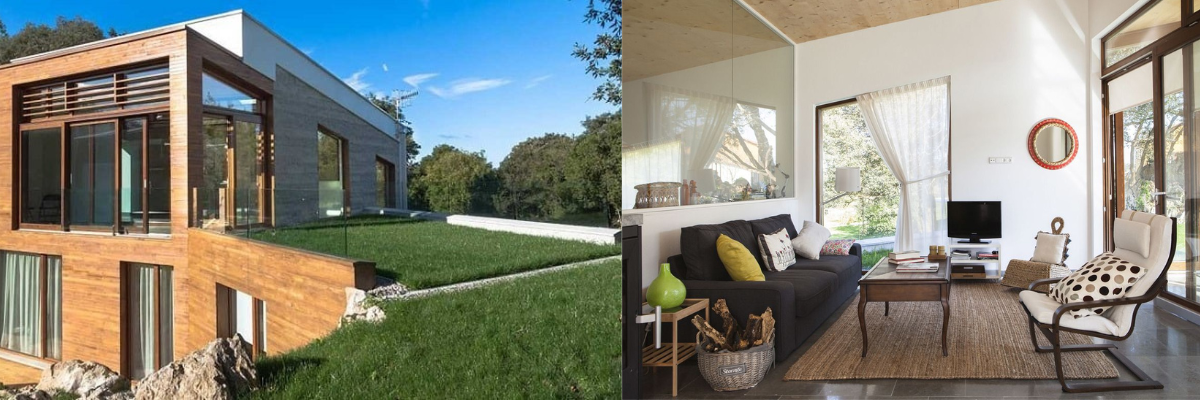
This house in Llanes (Asturias), designed by the architect Duqueyzamora, was built in 2012 and is officially certified by the Passivhaus Institute. 80% of all products in this home are renewable energies: individual electric boiler, water radiator, individual electric boiler, solar panels, and a wood-fired boiler. This dwelling, which initially has a lifespan of 75 years, uses ecological materials such as: cork insulation; wooden structures; cellular glass insulation; polypropylene pipes, wiring, and electrical material. PVC-free curtains and blinds, natural flooring with limestone floors, and bamboo slats.
Geodesic House in Jumilla
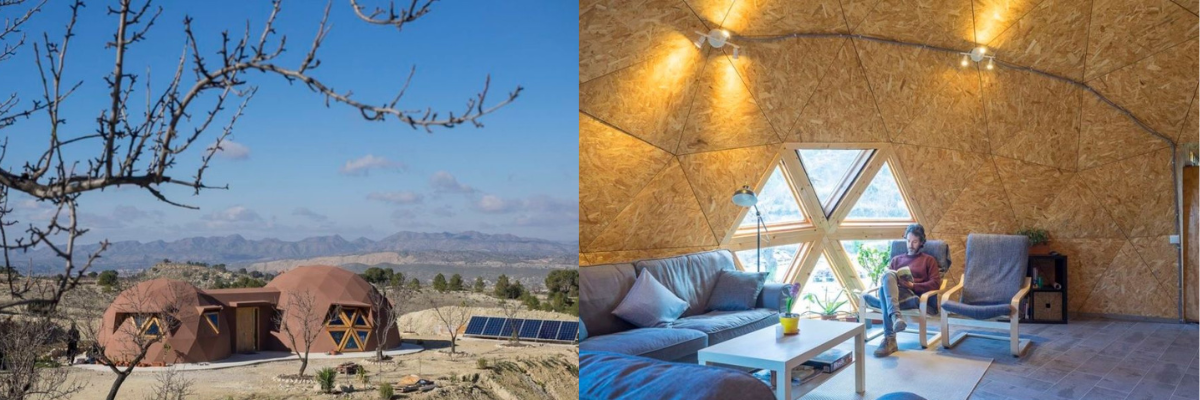
This geodesic house is located on a rustic plot in Jumilla (Murcia), on the northern slope of the Sierra de la Pila Regional Park. It is a small 85 m2 house for a couple. This house is another good example of a passive dwelling, which adheres to the basic principles of Passivehaus.
The passive house has no electrical or water supplies, uses renewable energies, and water purification systems to be self-sufficient. This creation consumes only 10% of energy.
Can Tanca House in Ibiza
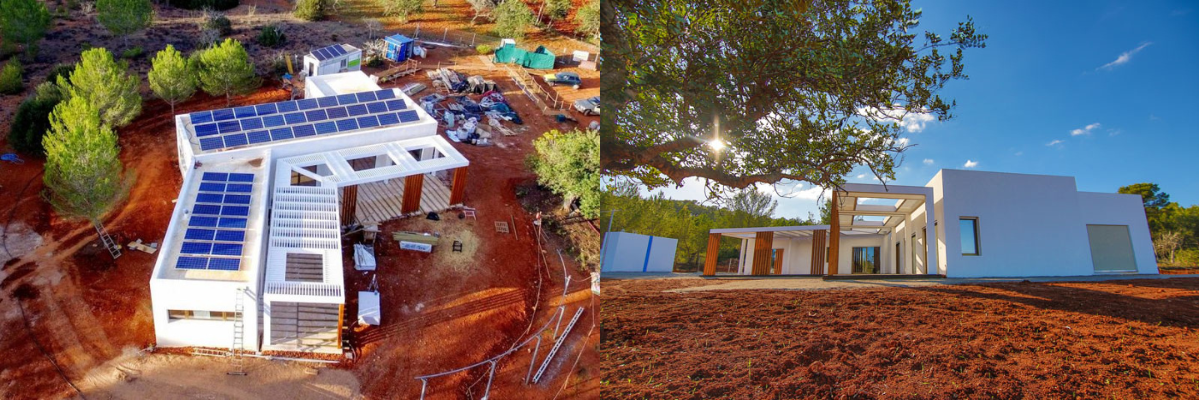
Can Tanca is a single-family dwelling located in Ibiza, Balearic Islands, designed by the architect Álvaro Martínez Gil. This dwelling also has the Passivehaus certificate and is a benchmark in sustainable construction. It operates completely disconnected from the electrical grid and water supply.
Villa Moraira
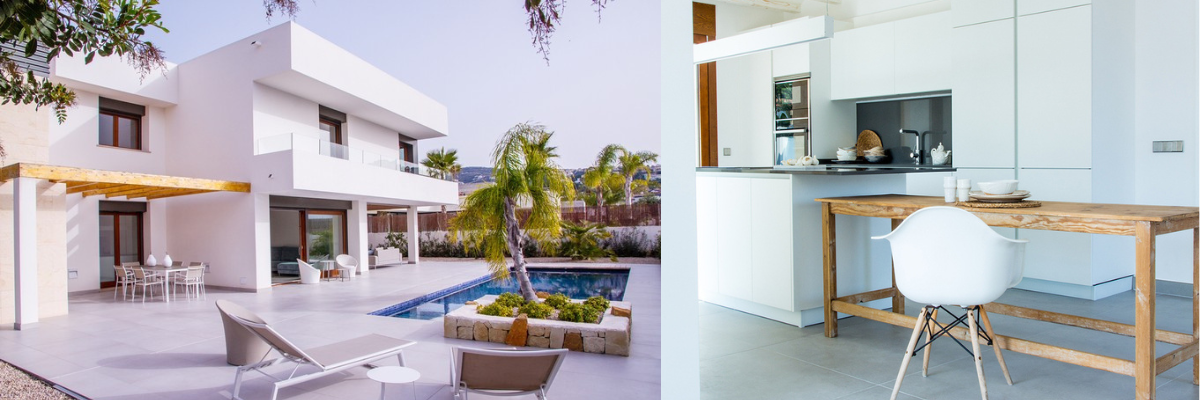
Villa Moraira, in Alicante, is a three-story single-family Passivhaus built with concrete. It also has the Passivehaus certificate. It is another example of a passive dwelling.
Bioclimatic House in Barcelona
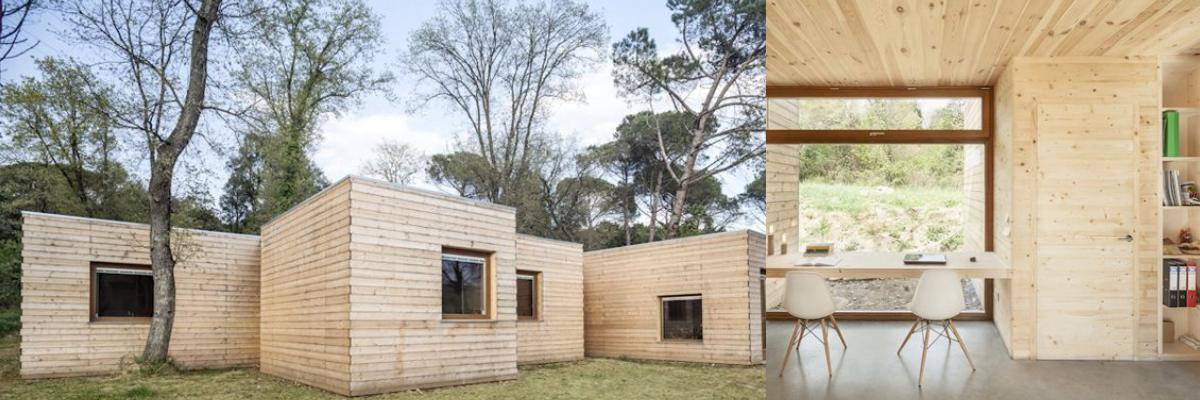
Another example of a passive house that meets almost all bioclimatic and energy efficiency requirements. Designed by Alventosa Morell. The house is located near the Montseny natural park, one of the oldest natural places in Catalonia.
The construction consists of natural and breathable materials, avoiding any type of condensation and possible harmful effects on health. Renewable systems are installed that allow considerable energy savings, such as the installation of solar panels. Thus, an energy saving of 77% is achieved compared to a conventional dwelling.
SONEU House in Xanxenso
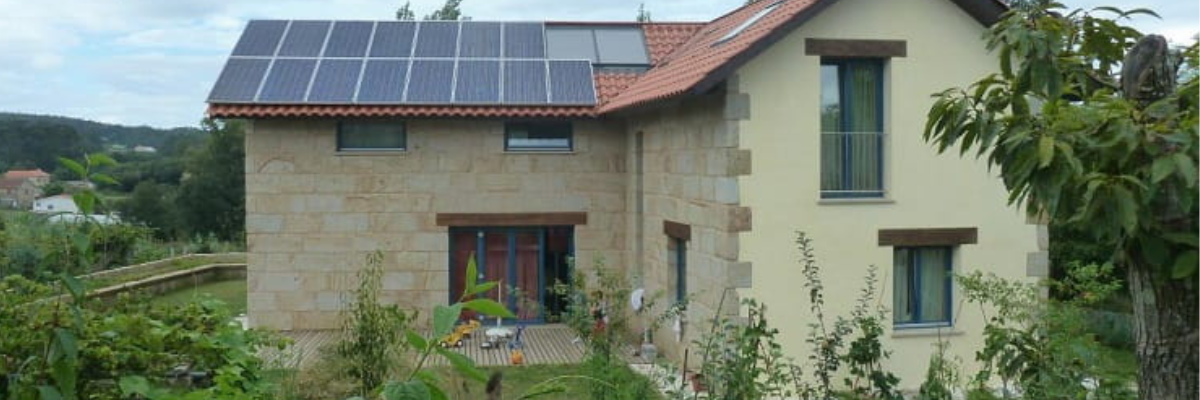
SONEU House in Pontevedra was built in 2012. It is a new single-family dwelling designed under the Passivhaus standard and Bioconstruction criteria. The total construction cost of the building is €195,569 and it has an A-class energy certificate. The total renewable energy production of this dwelling is 95%, and it has a lifespan of 75 years.
In terms of renewable energy systems, it has utilized: electric boiler, solar panels, biomass stove, and cooling through Canadian wells.